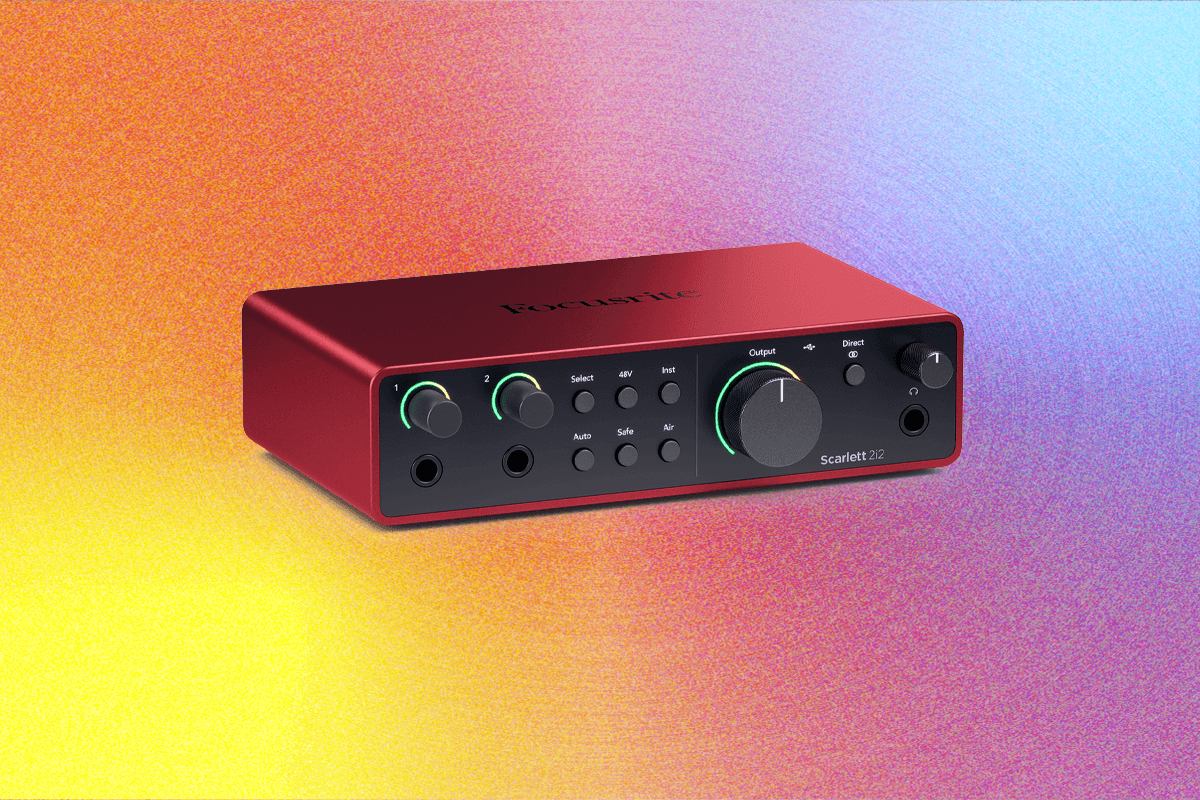The Best Audio Interfaces for Home Recording or Podcasting
We’ve tested dozens of the most popular USB audio interfaces and found the best sounding and easiest to use in your home studio.
All products featured on WIRED are independently selected by our editors. However, we may receive compensation from retailers and/or from purchases of products through these links. Learn more.
Featured in this article
I am firmly a member of the home recording revolution. Over the past decade or so, I’ve gone from making rough-and-tumble mixes on a simple four-channel tape deck to dozens of channels, outboard gear, and about a mile of microphone and patch cables. The technology has skyrocketed, even in the decade I’ve been recording regularly at home, with fast and faster (and easier, easier-to-use, better-sounding) recording devices being released by virtually every major pro audio brand.
The issue? That makes it hard to choose the best audio interface for you. While you can very nearly throw a dart at Sweetwater’s product list to find what you need, we’ve put each of the below devices through their paces, aiming to tell you what makes each unique.
As usual, be sure to check out our other audio coverage, including the Best Audio Recording Software, Best USB Mics, and Best Headphones, as well as our tips on how to improve audio quality.
How We Test Audio Interfaces
We test audio interfaces by using them. Many WIRED staffers and contributors are professionally trained musicians and hobbyists, and we are constantly making and recording music. We typically put these devices through their paces doing exactly what they advertise doing best, whether that’s checking each mic preamp to make sure they sound good, to testing instrument I/O and MIDI capabilities, where applicable. Some of these devices even come with dedicated plugins and software, which makes testing them with our laptops and DAWs of choice key.
Larger multi-channel interfaces are tested with multiple mics connected at once, and smaller devices are also tested for their maximum inputs and outputs. We typically use standard XLR cables, dynamic, condenser, and ribbon mics, along with testing instrument DIs on guitars and keyboards.
How Much Does an Audio Interface Matter?
These days? They all sound pretty awesome in terms of providing decent signal-to-noise ratio from mic preamps and instrument inputs, and good analog-to-digital conversion. It’s more about what features you need in an interface.
Are you looking to record a keyboard or guitar and a vocal, or are you looking to record an entire drum set? Do you have outboard gear you would like to connect? What about keyboards or other audio interfaces? This can all impact what you choose to buy.
Some audio interfaces are also better integrated to certain software or use cases; some of the devices below are tiny and meant to throw in a bag, some of them are designed to be screwed into a rack mount, and some are great on a desktop. It all depends what you’re trying to do. Spending more on an interface doesn’t necessarily mean you’ll make better records. It’s more about the source than what hardware you use to record it. This isn’t like cameras: Plenty of real professional folks record amazing-sounding things with affordable interfaces like the ones below.
What about Microphones, Headphones, and Cables?
Apart from your acoustic space and the player or person you’re trying to record, one of the most important choices you can make is what microphone to use. I recommend starting with a standard dynamic microphone like a Shure SM57 ($108) or SM58 ($109) and moving up to a larger diaphragm condenser mic like the Audio-Technica AT2020 ($119) for instruments like acoustic guitar, vocals, and piano (as well as essentially everything else you could want to record) when you have a bit more cash to do so. Down the line, you can explore things like ribbon microphones and small diaphragm condensers, but a simple dynamic/condenser pair is more than enough to make the vast majority of records, so long as you’re not recording a drum kit.
If you are recording a drum kit? I highly recommend just starting with a microphone pack like this one from AKG ($481). They aren’t the highest-end mics on the planet, but they’re more than enough to get good drum sounds when first starting out, so long as you can play and tune your drums the way you like them.
For headphones, I recommend you snag a nice wired pair of closed-back over-ears like those from Beyerdynamic or Sony. These allow less bleed from what you’re listening to (and recording over) into the microphone.
As for cables and stands: They really don’t matter that much if you’re not constantly messing with them. I recommend getting either colored cables or ones with colored ends, because it really helps visually remind you what is going where when you have lots of cables going everywhere. For stands? I actually love a simple swing-top desktop mic stand ($22) if I’m just recording vocals, percussion, or acoustic guitars. If I need something for a heavier mic or for a more open space, I prefer K&M stands ($102). They’re a bit more expensive than Amazon specials, but they’re very durable; I have yet to break one.
-
The Best Audio Interface for Beginners
The Focusrite 2i2 interface is likely the first interface that all of your favorite musicians and producers bought themselves. These red boxes have two microphone or instrument channels with 69 dB of gain, which is more than enough for even the toughest-to-power mics, and they sound utterly decent in most situations.
The USB-C design makes it easy to pair with any modern computers and ensures that it has super low latency, so you won’t have trouble lining up multiple takes on top of each other. There are two analog outputs, too, should you want to re-amp something or use any outboard gear. Pair this 24-bit, 192-kHz-capable interface with a cheap mic like a Shure SM57 and a decent pair of over-ear headphones, and you can make essentially any record or podcast you want in exceptional quality.
Specs Connectivity USB-C Microphone Inputs 2 Instrument Inputs 2 Headphone Outputs 1 Analog Audio Outputs 2 MIDI In/Out? N/A ADAT In/Out? N/A -
Best Audio Interface for Mac
Courtesy of Universal Audio
Universal Audio
Apollo Twin X Duo (Gen 2)
It costs about a thousand dollars more than the Focusrite Scarlett and offers the same amount of microphone channels, but that’s for good reason: Universal Audio interfaces are the industry standard, and this specific “two channel” interface actually offers four line outs, an instrument input, and optical inputs for expanding with other digital interfaces (like its excellent 4710d).
The secret sauce inside Universal Audio (UAD) interfaces is their dual unison mic preamps, which use DSP to recreate some of the most famous circuits on the planet with surprising accuracy while lightening the load on your internal processor. When you buy UAD interfaces, you’re not simply buying a good mic pre, you’re buying a chameleon that can imitate many of the most famous audio devices ever without causing your laptop to catch fire. The processing is lightning-fast thanks to dual- or quad-core models, and these come bundled with a wide assortment of free plugins and software, which are nice-to-have additions for a product that costs this much.
If you look hard enough, you’re likely to see one of these well-made metal interfaces on the desks or in the laptop bags of a shocking percentage of your favorite musicians; they’re really that good.
Specs Connectivity Thunderbolt 3 Microphone Inputs 2 Instrument Inputs 1 Headphone Outputs 1 Analog Audio Outputs 4 MIDI In/Out? N/A ADAT In/Out? Yes (1)
-
Best Interface for Larger Sessions
Courtesy of Universal Audio
Universal Audio
Apollo X8p
While open-source crusaders and techno-libertarians are applauding Universal Audio’s recent efforts to move away from its “walled garden” approach to plug-ins, the truth is that most of the good ones still require the presence of an interface or a processor core to load up and run in your DAW of choice. As we mentioned in the write-up of the Apollo Twin, above: “good” is a massive understatement when describing UAD’s most popular plug-ins.
Its digital re-creations of optical mix bus compressors, legendary reverbs, and warm, vibey tape machines are unmatched by any other prosumer-level manufacturer, and the fact that its hardware powers the CPU-hungry algorithms that apply the magical high-end sheen to your mix makes the pricey leap into the UA universe well worth it.
Direct monitoring on the four included XLR unison preamps is crystal clear, nearly latency-free, and loaded with clean headroom for anything you plug into it. A wide array of inputs like a pair of ADAT I/Os and eight line-level 1/4″ jacks can handle sessions of all sizes, and the UA Console app makes routing, monitoring, and plug-in management a breeze. If you go to a major studio, this is the most common interface you’ll see, often with multiple stacked together for even more channels, which you can do with a single cable between devices. —Pete Cottell
Specs Connectivity Thunderbolt 3 Microphone Inputs 4 Instrument Inputs 2 Headphone Outputs 2 Analog Audio Outputs 8 MIDI In/Out? N/A ADAT In/Out? Yes (2) -
The Best Interface For Podcasts
SSL 12 USB
Solid State Logic is one of the most famous makers of studio recording desks—the type of thing you might dream of recording through in the real world in London, New York, Atlanta, or LA. The brand modeled its own legendary SSL4000 console to give you that flavor on your mic preamps on the way in (just press the 4K button) on the top of the unit. Even without that mode engaged, these preamps sound clean and sparkling, and there are four analog outputs as well as—great for synth nerds—MIDI in and out. You can even send a signal to it from other digital gear via ADAT. Another reason to buy? The awesome blue volume knob on the front, which is one of the most satisfying in the business. Two headphone outputs make this a great interface for recording podcasts; as long as you have a pair of headphone splitters, you can use this for up to four people.
Specs Connectivity USB-C Microphone Inputs 4 Instrument Inputs 2 Headphone Outputs 2 Analog Audio Outputs 4 MIDI In/Out? Yes ADAT In/Out? Yes (1)
-
Best Budget Interface for Mobile iOS Rigs
The sub-$300 USB interface market is crowded as ever, so it takes some thoughtful flourishes for a device to stand out. We love the Arturia MiniFuse 4 for its beefed-up connectivity, accessible design, and plug-and-play connectivity, which makes it an excellent pick for mobile producers who need flexible routing and easy power supply options in just about any scenario.
The MiniFuse 4 is bus-powered like any good mobile USB-C interface; however, it also includes its own external power supply that powers most tablets to which it’s connected, as well as any devices connected to its two USB-A hub jacks. These are great for MIDI controllers, trigger pads, and just about any other peripheral device you’ll use while you’re dropping into a session for an on-the-fly performance. —Pete Cottell
Specs Connectivity USB-C Microphone Inputs 2 Instrument Inputs 2 (2 line ins) Headphone Outputs 2 Analog Audio Outputs 4 MIDI In/Out? Yes ADAT In/Out? N/A -
Best Interface for Synth Nerds
It makes perfect sense that the first truly synth-forward audio interface is produced by a European purveyor with control voltage coursing through its veins. With several blockbuster pieces of kit to their name, Arturia is a name you can trust when it comes to all things related to synths–and now they’re a standout player in the interface game with its AudioFuse 16rig (see our full review here).
This 1U rack-mount interface is equipped with 16 1/4″ line level inputs on the back, which means you no longer need to invest hundreds of dollars in direct boxes to get a clean signal from your synth, groove box, or sampler. Just plug it in, use the intuitive matrix router in the included software to route its signal to whichever analog and/or digital output you see fit, and you’re good to go.
The staggering amount of inputs is enough to excite most, but Arturia also included all sorts of thoughtful bells and whistles that make the 16rig an easy choice as the heart and brain of your synth rig. Five-pin and USB MIDI I/O, a USB hub input, dual ADAT I/O, and DC-coupled outputs for CV connections to modular synths make this an all-in-one solution that’s yet to be outgunned by even the biggest names in the interface game. —Pete Cottell
Specs Connectivity USB-C Microphone Inputs 2 Instrument Inputs 16 line inputs Headphone Outputs 1 Analog Audio Outputs 10 MIDI In/Out? Yes ADAT In/Out? Yes (2)
-
Best Interface for Drummers
I have used and loved my previous-generation Presonus Quantum interfaces to track drums for years, and the only thing that has me wanting to upgrade is the newer Quantum HD model with automatic level-setting (see our full review here).
You can simply press a button on the interface and play away; the interface will set the microphone preamp to what it thinks is the sweet spot based on your volume. As a drummer who is tired of running back and forth from my kit to my desk a million times to do this the old-fashioned way, I think of this technology as nothing short of a revelation.
Pair the eight channels of mic preamps with Presonus’ Studio One (my personal favorite recording software) and you’ll even be able to dial in the gain on the preamps from inside the software, as well as turn on phantom power, which is a nice touch. A USB-C connection and fast processing mean that this interface has essentially zero latency, and the onboard preamps are clean and clear, ready for whatever digital or analog dirt you want to put in front or behind them. Like the larger UAD model above, you can stack these together using USB-C, allowing you to have tons of channels when you need them.
Presonus also has a two-channel version that is cheaper but has the same amazing level-setting feature.
Specs Connectivity USB-C Microphone Inputs 8 Instrument Inputs 2 (stereo) Headphone Outputs 2 Analog Audio Outputs 10 MIDI In/Out? N/A ADAT In/Out? Yes (4) -
The Coolest Portable Interface
Like most Teenage Engineering gear, the TX-6 (see our full review here) is stylish, quirky, expensive, and impossible to put down once the gestures required to operate it are committed to muscle memory. A total of six stereo inputs in a device the size of a deck of playing cards is insane, and the addition of features like Bluetooth MIDI, built-in synth and drum engines, an aux send, a cue output, and a bevy of channel strip parameters like gain, EQ, and compression put comparably priced units that are 10 times its size to shame.
With minuscule size comes great tradeoffs, so it may take some extra time (and money) to get used to utilizing the TX-6 to its fullest capacity, but once you do, the idea of schlepping around an inexpensive two-channel interface the size of Infinite Jest becomes very unappealing. —Pete Cottell
Specs Connectivity USB-C Microphone Inputs N/A Instrument Inputs 6 Headphone Outputs 1 Analog Audio Outputs 3 MIDI In/Out? N/A ADAT In/Out? N/A
Parker Hall is a senior editor of product reviews at WIRED. He focuses on audiovisual and entertainment products. Hall is a graduate of the Oberlin Conservatory of Music, where he studied jazz percussion. After hours, he remains a professional musician in his hometown of Portland, Oregon. … Read More



-Reviewer-Photo-SOURCE-Parker-Hall.jpg)




